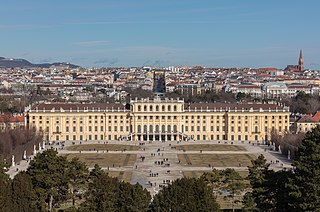
Vienna is the national capital, largest city, and one of nine states of Austria. Vienna is Austria's most populous city, with about 2 million inhabitants, and its cultural, economic, and political center. It is the 6th-largest city by population within city limits in the European Union.

Schönbrunn Palace was the main summer residence of the Habsburg rulers, located in Hietzing, Vienna. The name Schönbrunn has its roots in an artesian well from which water was consumed by the court.

Austrian cuisine is a style of cuisine native to Austria and composed of influences from Central Europe and throughout the former Austro-Hungarian Empire. Austrian cuisine is most often associated with Viennese cuisine, but there are significant regional variations.

Meidling is the 12th district of Vienna. It is located just southwest of the central districts, south of the Wienfluss, west of the Gürtel belt, and east and southeast of Schönbrunn palace. Meidling is a heavily populated urban area with many residential buildings, but also large recreational areas and parks. In sports, it is represented by the FC Dynamo Meidling. The Chancellor of Austria Sebastian Kurz was raised in Meidling and his private residence is there.

Apple strudel is a traditional Viennese strudel, a popular pastry in Austria, Bavaria, the Czech Republic, Northern Italy, Slovenia, and other countries in Europe that once belonged to the Austro-Hungarian Empire (1867–1918).

Hietzing is the 13th municipal District of Vienna. It is located west of the central districts, west of Meidling. Hietzing is a heavily populated urban area with many residential buildings, but also contains large areas of the Vienna Woods, along with Schönbrunn Palace.

A strudel is a type of layered pastry with a filling that is usually sweet, but savoury fillings are also common. It became popular in the 18th century throughout the Habsburg Empire. Strudel is part of Austrian cuisine but is also common in other Central European cuisines. In Italy it is recognized as a traditional agri-food product (PAT) of South Tyrol.
Austrian culture has been influenced by its past and present neighbours: Germany, Hungary, Slovenia, Italy, and Bohemia.

Kaffee Alt Wien is a traditional Viennese café located at Bäckerstraße 9 in the Innere Stadt first district in Vienna, Austria. It was established in 1936 by Leopold Hawelka and his wife Josefine on the day after their wedding. They ran the café until 1939 at which time they moved to Dorotheergasse, where they opened a new coffee house, the famous Café Hawelka.

Paul Strudel or Paul Strudl was an Austrian sculptor, architect, engineer, and painter, ennobled as Baron von Strudel and Vochburg.

The sculptures in the Schönbrunn Garden at Schönbrunn Palace in Vienna, Austria were created between 1773 and 1780 under the direction of Johann Wilhelm Beyer, a German artist and garden designer. The Great Parterre of Schönbrunn Garden is lined on both sides with 32 over life-size sculptures that represent mythological deities and virtues. The Neptune Fountain at the foot of the Gloriette hill is the crowning monument of the Great Parterre. Other sculptures are distributed throughout the garden and palace forecourt, including fountains and pools. Several sculptors were employed during the execution of these works, among them Johann Baptist Hagenauer.

Viennese cuisine is the cuisine that is characteristic of Vienna, Austria, and a majority of its residents. Viennese cuisine is often treated as equivalent to Austrian cuisine, but while elements of Viennese cuisine have spread throughout Austria, other Austrian regions have their own unique variations.

The KunstHausWien is a museum in Vienna, designed by the artist Friedensreich Hundertwasser. This museum in the Landstraße district houses the world's only permanent exhibition of Hundertwasser's works, and also hosts regular temporary exhibitions of other artists. The KunstHausWien operates as a private business and does not receive any government aid. In 2009 the KunstHausWien received 174,000 visitors.

The tourist attractions of Vienna concentrate in three distinct areas. The largest cluster, centred on Schönbrunn Palace, attracted around five million visitors in 2009, down from six million in 2008. Museums and exhibitions of Hofburg Palace accounted for nearly two million visitors in 2008, with a significant decline in 2009. The third, and the newest, cluster of modern art museums in Museumsquartier attracted less than one million visitors. Nearby duo of Kunsthistorisches and Naturhistorisches museums, located halfway between Museumsquartier and Hofburg, also reported around one million visitors. The Landstraße district, which lies south-east of the old city, is home to art exhibitions at the Belvedere Palace and the KunstHausWien.

The milk-cream strudel is a traditional Viennese strudel. It is a popular pastry in Austria and in many countries in Europe that once belonged to the Austro-Hungarian Empire (1867–1918). The milk-cream strudel is an oven-baked pastry dough stuffed with a filling made from diced, milk-soaked bread rolls, egg yolk, powdered sugar, butter, quark, vanilla, lemon zest, raisins and cream and is served in the pan with hot vanilla sauce.
The following is a timeline of the history of the city of Vienna, Austria.

Café Museum is a traditional Viennese café located in the Innere Stadt first district in Vienna. The café opened in 1899. The original interior was designed by renowned architect Adolf Loos. The café became a meeting place for Viennese artists.

Franz Anton von Zauner was an Austrian sculptor who worked in the Neoclassical style.

The following outline is provided as an overview of and topical guide to Vienna:

Schlosstheater Schönbrunn is a stage at Schönbrunn Palace in Vienna which opened in 1747. The Baroque theatre now serves for the training of students of acting and opera of the University of Music and Performing Arts Vienna (MDW), and for performances of the Musik Theater Schönbrunn.

















